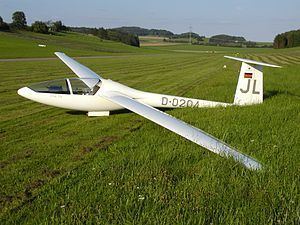Top speed 250 km/h Length 6.6 m Designer Eugen Hänle | Wingspan 19 m Manufacturer Slingsby Aviation | |
 | ||
Slingsby kestrel ok 5901 lkhs hos n
The Slingsby T.59 Kestrel is a British Open class glider which first flew in August 1970. Of fibreglass construction, it features camber-changing flaps, airbrakes, and a retractable main wheel.
Contents
- Slingsby kestrel ok 5901 lkhs hos n
- Notable competition use
- World record use
- Variants
- Aircraft on display
- Specifications T59D Kestrel 19
- References
Originally a licensed built version of the Glasflügel 401, the Kestrel was produced in several variants culminating in the T.59H of 22 metres (72.2 ft) wing span. The type was successful when used in gliding competitions and was the first glider to complete a 1,000 km (621 mi) pre-declared task.
Notable competition use
World record use
The 1,000 km out and return pre-declared task world distance record was broken in September 1972 by New Zealander, Dick Georgeson. Covering a distance of 1,001.94 km (622.58 mi) in lee wave this was the first time that this pre-declared distance task had been completed.
Variants
Aircraft on display
Specifications (T.59D Kestrel 19)
Data from Jane's.
General characteristics
Performance
